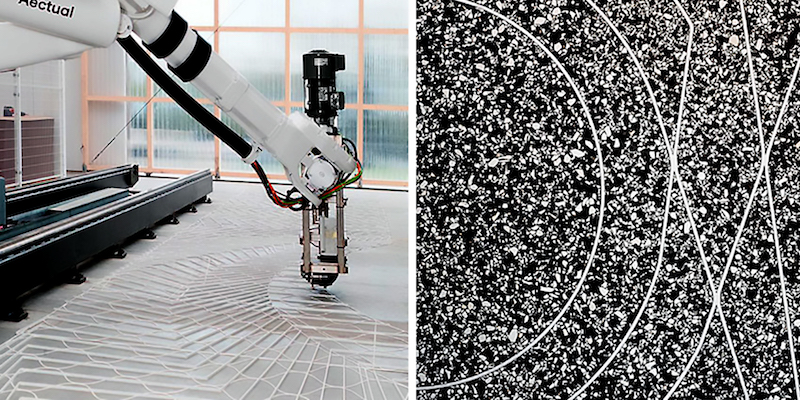This article has been originally published as part of the column FABBRICATION in XXI magazine, vol.156, February 2017. This article can be accessed here in Turkish.

It is possible to find videos of robotic arms dancing to Ottoman military march and waving Turkish flags in the depths of Youtube. THAT is tool porn.
We really do not like bullshitting. Thus, we cut directly to Harry G. Frankfurt for the best diagnosis ever made on bullshit and the bullshitter:
Bullshit consists of lack of concern for the difference between truth and falsity. Motivation of the bullshitter is not to say things that are true or even to say things that are false… The question of what he says is true or false is irrelevant to his pursuit of ambition. Bullshitter is not necessarily a liar, what he says may very well be true and he may not think that it is false.1Harry Frankfurt
The keyword here is concern. A liar (or anyone that takes a position against a perceived notion of truth) knows what the truth (or believed) is and is concerned to steer people away. It roots its raison d’etre on a perceived notion of truth, whereas the bullshitter does not care, AT ALL. Bullshit does not even provide a false belief on a subject, it is intended to give the audience a false impression concerning what is going on in the mind of the bullshitter.
Design operates in murky waters. Decisions taken towards meeting functional criteria can be measured, thus quantifiable. They can be placed on a scale of true (serves its purpose) and false (useless). On the other hand, the intuitive decisions fall beyond the scope of this scale. They introduce a personal relativity. Designers, having learned in school that they are responsible for all their actions, start to obfuscate like mad to turn this relativity in their favor. And the bullshitting ensues. We have to agree with Michael Beirut on this one; every design presentation is inevitably, at least in part, an exercise in bullshit.2
Welcome to the three part series on bullshit we have experienced (and selected only the very best) in our field of interest. We will start with people’s lust for tools and how they regard new tech as objects of fetish. Next, we will examine the futile attempts in cross-breeding methodologies to justify the creation of design aberrations. Finally, we will delve into academia where minds are poisoned for the very first time.
Intense programs devised to encounter the lacking points of academia in an attempt to offer concentrated knowledge at a short amount of time sometimes fell victims of bullshit, solely becoming profitable businesses with global brands. Providing content on chic architectonics and flashy fabrication methods is a guaranteed method to draw an audience. Planning the course of action is straightforward; review the last editions of biennials, distinguish the popular works, throw in some fabrication method (say, robotic) that would draw a lot of attention these days, et voila! You have got yourself a killer theme for a blockbuster program. Naturally, one might think that the methodology is the essence of such a program, considering that the expected outcome is a built structure. One would anticipate expert leads who are adept at building a certain type of architectonic structural system, or fluent in thinking rationally and computationally, or proficient in the design fabrication process to guide the novice. In the case of targeting solely the documentation of the outcome rather than focusing on the process, amusing anecdotes emerge as a result.
In an application which requires a high level of precision in fabrication – rightfully justifying the use of a robotic arm, the clueless might suggest introducing a randomness in fabrication process. The rationale of a bullshitter is simple. Robotic fabrication is hip, randomness is cool – so, why not both? We watch appalled, someone proposes a person to waggle the robotic arm every now and then to produce unpredictable outcomes for a supposed precise fabrication. Upon the realization that a pre-programmed arm might not work so well with humans as the robotic arm can injure with unpredictable movements, safety measures are taken. Taping a cell phone on three-hundred kilograms of steel and setting the phone to vibrate at all times to create sought after randomness effect was the second best idea to emerge. The negligence of any meaningful (true or false) methodology is beyond belief. This is pure gold. Bullshitting for the sake of bullshitting.
Prior to a gathering with the subject of architecture and new technologies, we were showcasing the production of a prototype for a seating unit using robotic hotwire cutting in real time. One of the invited guests, an architect notorious for his appetite for nonstandard shapes (doubtfully spatial), was awestruck. Mesmerized by the graceful cadenced movements of an orange arm producing some fancy geometry, he exclaimed “I want one in my office”, and stormed to the stage for the panel. We were taken by surprise while his assistants swarmed us. Was he referring to the seating units we were producing, or the end-effector that enabled the production of such geometries? Apparently, he was only referring to our “orange”. Never mind why/how/what the robot did, it would be a lavish mechanical toy to stand in the middle of his office for marketing purposes – dazzling clients with the high-tech pizzazz.
[i] Michael Beirut, of Pentagram, applies Frankfurt’s piece on design with On (Design) Bullshit https://designobserver.com/feature/on-design-bullshit/3347

Three robotic arms on top of a reception desk. Robots obviously need to be futuristic looking, does not matter if they exist in real life or not. Note the Asimo at the background.
Come to think of it, his lust for one robot seems rather innocuous compared to another case we were confronted with. After seeing our foyer attraction in the Innovation Week 20153, an architectural office contacted us. For the entrance foyer of an office in the Turkish Silicon Valley, they intended to place three robotic arms carrying a widescreen each to present a choreographed welcoming message to the visitors. There were few minor technicalities they apparently did not care. Placing a total of 2.5 tons of dynamic load on the ceiling of a structure which clearly was not designed accordingly was one of them. Not even mentioning the impossibility of operating robots due to kinematics in such a limited place for the choreography, the poor receptionists had to mind their head at all times as all three robots would be operating non-stop literally on top of them. Of course this applies if they manage not to get bored to death and escape due to the same message repeating with the same movements causing the robots to orchestrate the same monotonous mechanical symphony, more than hundred times a day, seven days a week, and four weeks a month. But hey, robots are the embodiment of informatics in steel and they are a must-item in entrance foyers, so it is all cool.
If the gratuitous use of robotic arms is the mechanical manifestation of bullshit, superfluous use of the term Artificial Intelligence is its equivalent in programming. Everything is smart, everything is powered by AI. We have not seen that much of AI in the field of architecture yet, but we have witnessed pre-rendered video mapping shows proclaimed as performances of artificial intelligence. Apparently, rendering particle physics based on established Newtonian laws requires an algorithm with a fitness function to be trained. Who would have known?

Still image from a self-proclaimed AI curated show. Naturally, AI exists in the form of a pixelated human head.
Random verse generators that existed as open source recreational projects for decades are marketed as artificial intelligence poets or rappers. Of course it is fun to read a random verse generated by a program, but does it really have to be marketed as an AI project? Can’t we just like something for being what it is, a random verse generator, and nothing else? Does it have to serve a higher purpose?
A common accomplice of AI and machine learning is Big Data, which is also on the radar of bullshitters as expected. “Big data is like teenage sex: everyone talks about it, nobody really knows how to do it, everyone thinks everyone else is doing it, so everyone claims they are doing it…”4 Utilizing big data requires thorough understanding of the problem and a rigorous methodology for the classification of data. If we start with only the data available online, overwhelm the reader by fancy graphics with no intentional (but only accessible) content, we are merely bullshitting through the language of data graphics – exploiting the very profession we practice. It is just as superficial as evaluating architectural quality based on the size or price per square meter of an apartment. It is a blatant disregard for Genius Loci, the spirit of a place only to be experienced by physical existence, and not solely through virtual interfaces. We are not criticizing the intention to understand/read a portion of the city, however this dataset is nowhere close to being enough input for design. Claiming otherwise would be a sensational clickbait title.
Lust for new tools is a very insidious threat undermining potentials of new technologies. Bullshitting with a new tool spawns a wave of distrust, distracts progress in a dedicated direction, raises skeptical eyebrows, banalizes the public perception and tampers the efforts of the devoted researchers. It introduces the perfect boy who cried wolf scenario.
We are aware that not every progress is the result of designed, calculated actions. Unexpected accidents, or improvised acts sometimes do trigger breakthroughs. However, these are not the same as bullshitting-on-the-go. These are failed acts towards a goal that become a phenomenon on their own, not false impressions covering up the lack of substance behind a display. So if you really have to bullshit, please bullshit responsibly.

Upon bullshitting on 3D-printing a canal house, DUS Architects’ spinoff Aectual finally put 3D printing in large scale with robots in a sensible project – towards the creation of large terrazzo pieces as flooring.
- Harry Frankfurt’s “On Bullshit” discusses bullshit in depth, but his brief view on the subject can be found on https://www.youtube.com/watch?v=W1RO93OS0Sk&t
- Michael Beirut, of Pentagram, applies Frankfurt’s piece on design with On (Design) Bullshit https://designobserver.com/feature/on-design-bullshit/3347
- Shout out to NOHlab and Audiofil.
- Dan Ariely on Big Data.
